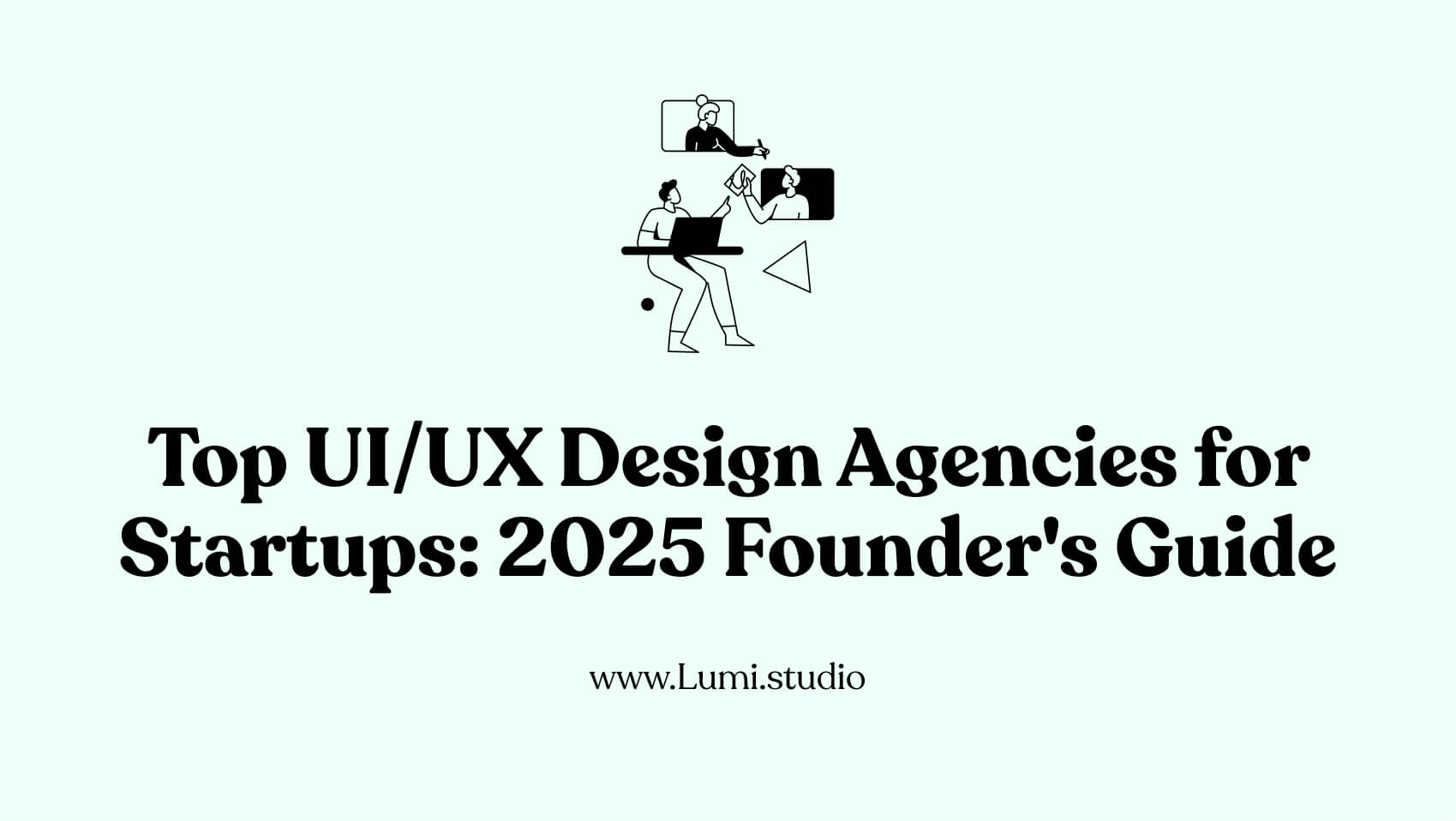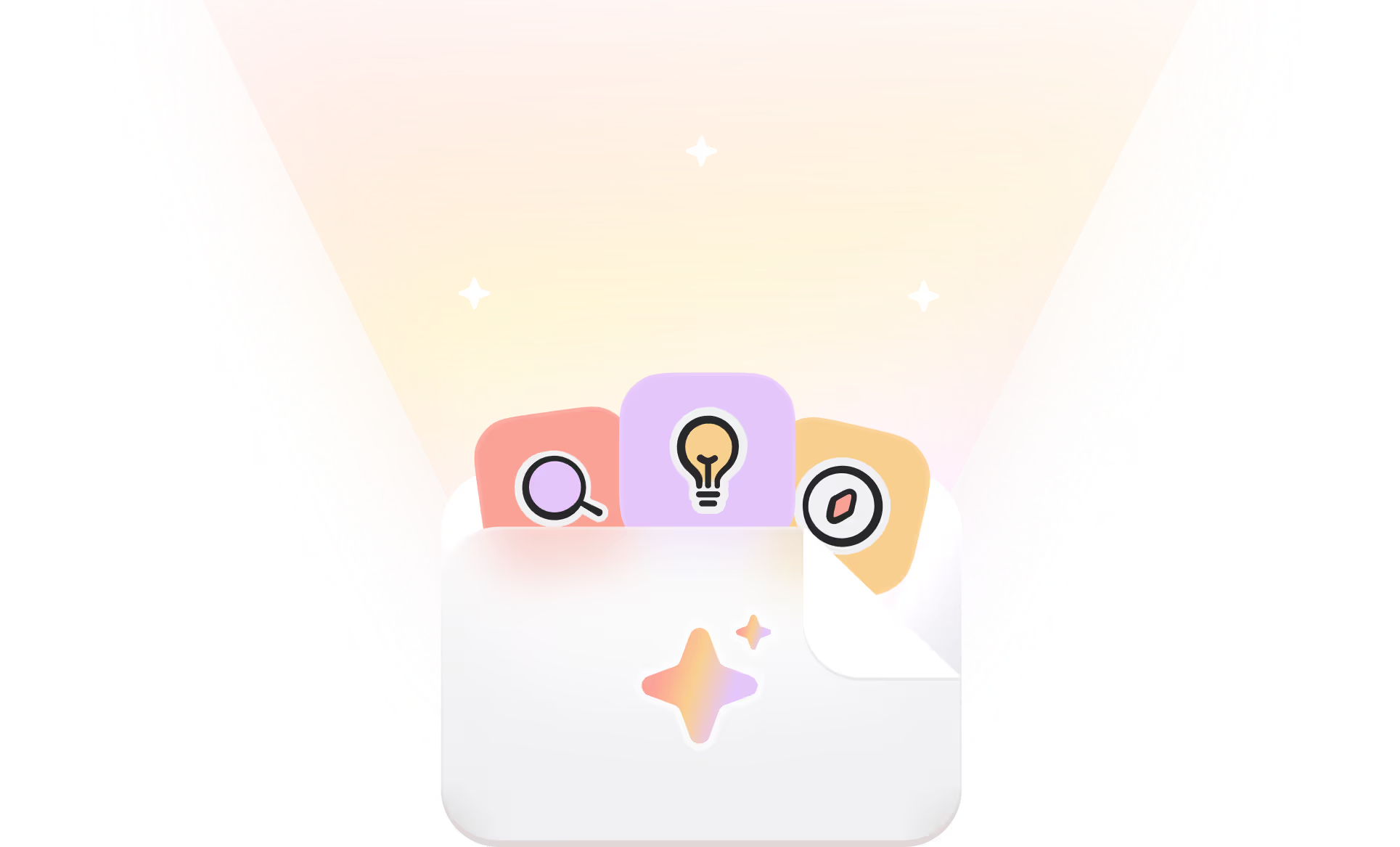Every $1 invested in UX design returns $100. That’s a 9,900% ROI.
The startup UI/UX design agency you choose is going to architect the foundation of your success – the experience that will convert visitors into users, customers, and advocates.
👉 At Lumi, we work with founders every day and know what makes agencies that accelerate startup growth. After vetting hundreds of agencies worldwide, we’ve curated this definitive 2025 list of partners that understand startup realities.
This guide will help you decide which UX agency to work with across every budget range, geographic region, and startup stage. ⬇️
How we chose these UX agencies for startups
How we chose the best UI/UX agencies for startups (2025):
- Proven startup track record
- Full-service UX research + design
- Flexible engagement models
- Verified results with metrics
- Global talent and remote-first capabilities
- Startup-focused, agile approach
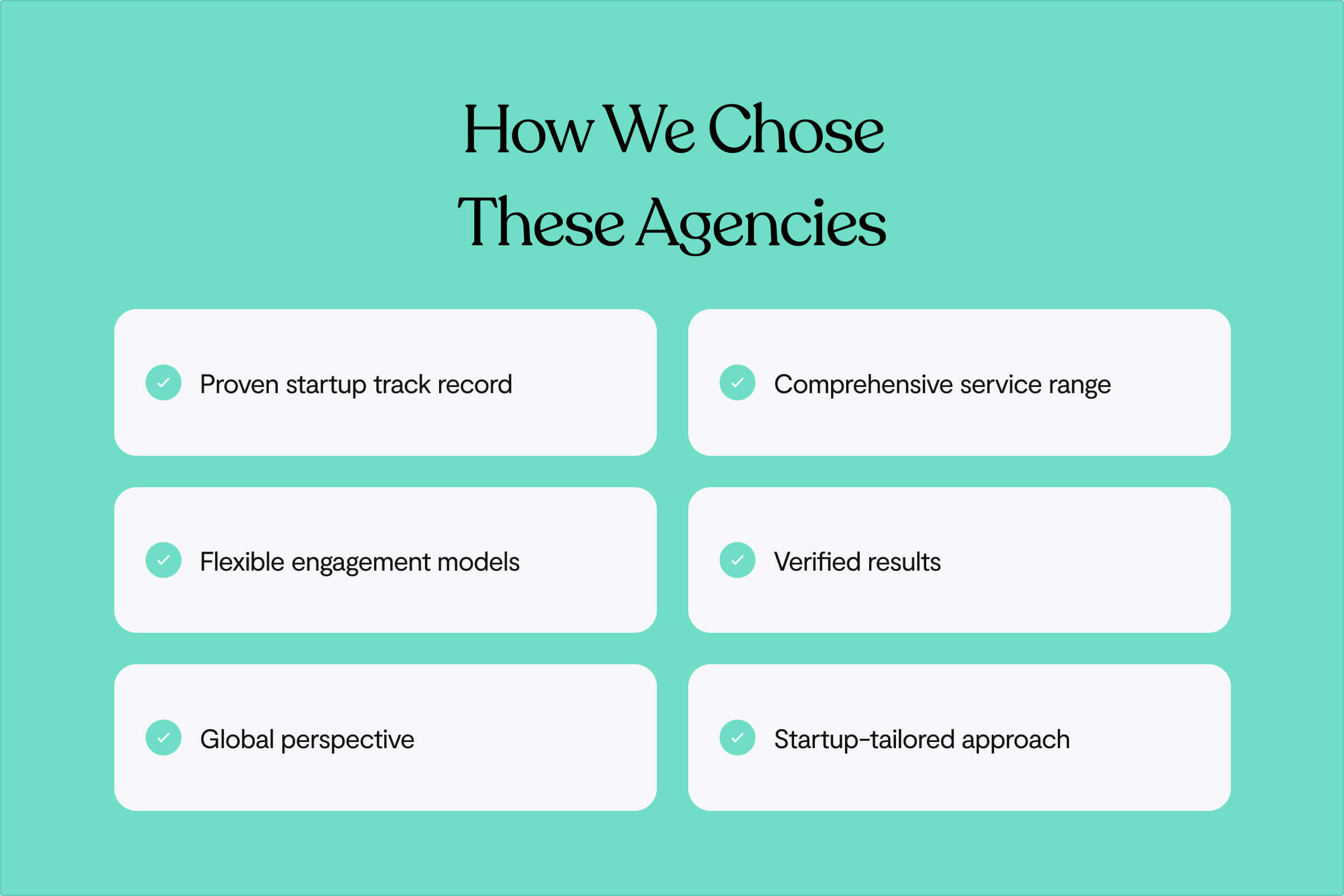
We evaluated each startup design agency through the lens of what matters to founders:
✔️ Proven startup track record
Real MVP launches, seed-to-Series A clients, and SaaS product experience, not just corporate rebrands.
✔️ Comprehensive service range
UX research, rapid prototyping, UI design, design systems, and seamless development handoff.
✔️ Flexible engagement models
Day-rate billing with month-to-month flexibility, allowing you to scale investment up or down based on your current needs and funding stage.
✔️ Verified results
Case studies with measurable outcomes: conversion improvements, faster time-to-market, successful funding rounds.
✔️ Global perspective
Options across US, Europe, Eastern Europe, and emerging markets – plus remote-first capabilities.
✔️ Startup-tailored approach
Agile methods, pivot-friendly processes, and understanding of investor expectations.
How to find the right UI/UX agency for your startup
Choosing a design partner has nothing to do with who has the flashiest Dribbble shots. The real differentiator lies in finding someone who understands startup constraints and amplifies your strengths.
How to choose a UI/UX agency for your startup:
- Look for real startup experience (MVPs, pivots, fundraising support).
- Check for agile methods like sprints and prototypes.
- Compare pricing models that fit your funding stage.
- Ask for measurable results (conversion, retention, speed-to-market).
- Make sure they can collaborate remotely across time zones.
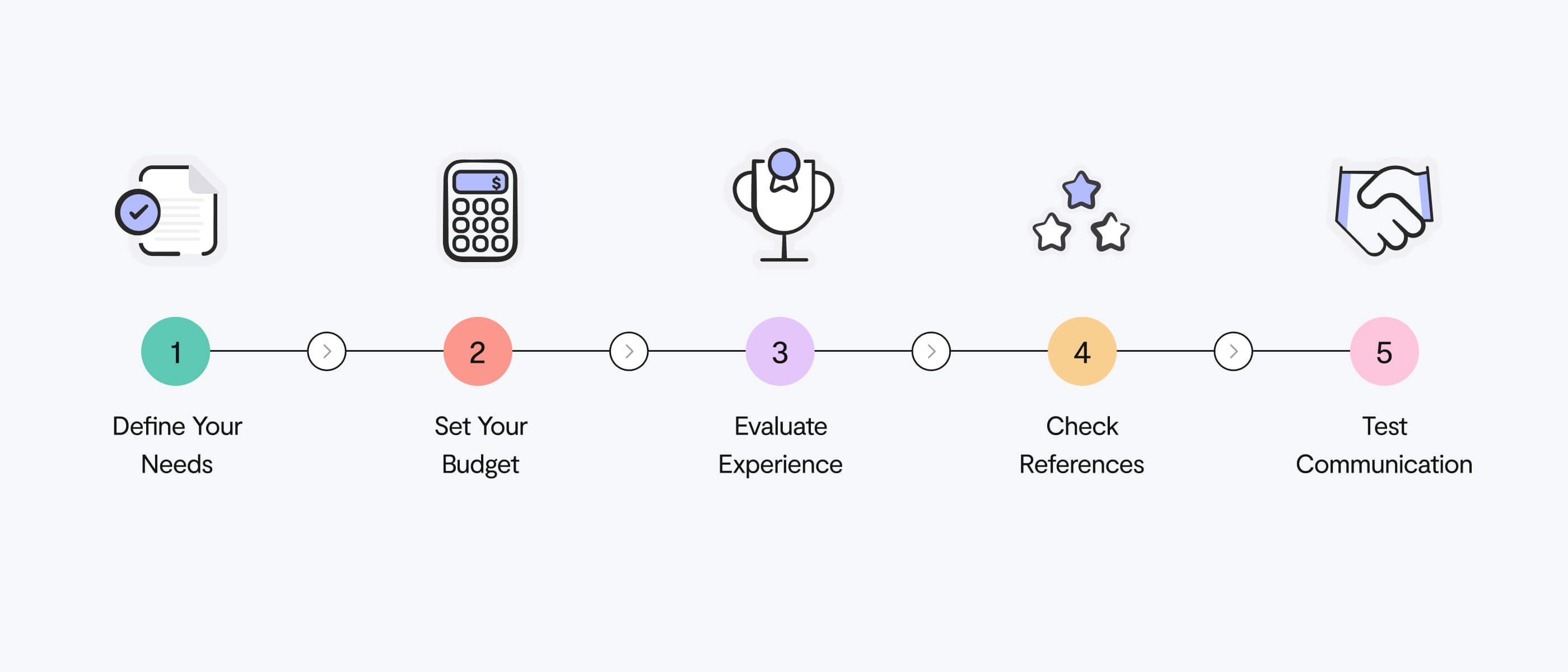
What to look for in a digital product design agency
🚀 Startup experience
Agencies that speak your language: fast pivots, lean budgets, demo days, and investor decks.
⚡ Agile methods
Sprint-based delivery, rapid iteration, and prototype-first approaches that keep you moving.
💰 Flexible pricing
Willingness to scale up during funding rounds and down during leaner periods.
📈 Measurable outcomes
Case studies showing conversion improvements, retention gains, and faster launch timelines.
🌍 Remote collaboration
Async-friendly processes and digital-first workflows that work across time zones.
UI/UX agency budget ranges and pricing models
Here's what you can expect to invest in UI/UX design services for startups across different models:
- Retainer models → $10,000 – $30,000+/month (depending on scope/team size)
- Project-based → $15,000 – $150,000 (MVPs or redesigns)
- Hourly rates → $50 – $250/hour (region & seniority matter)
💡 Founder tip: Ask whether pricing flexes with your stage. Good agencies grow with you, not against you.
5 questions to ask before hiring a UI/UX agency
✅ Have you worked with startups at my stage?
Look for specific experience with pre-seed, seed, or Series A companies in your vertical.
✅ What's your typical timeline for MVP launch?
Should be weeks, not months. Red flag if they can't commit to realistic deadlines.
✅ Do you provide dev handoff support?
Ensure they create developer-ready assets and can support your engineering team.
✅ How do you handle scope changes/pivots?
Startups change direction quickly. Your agency should embrace this, not penalise you for it.
✅ Can you share outcomes, not just visuals?
Look for conversion rates, user engagement metrics, and business impact.
Comparison table of UI/UX agencies (2025)

The 16 best UI/UX agencies for startups in 2025
Lumi Studio
🏷️ Best for Complete Product Partnership & Startup Success
📍 UK-based, globally distributed
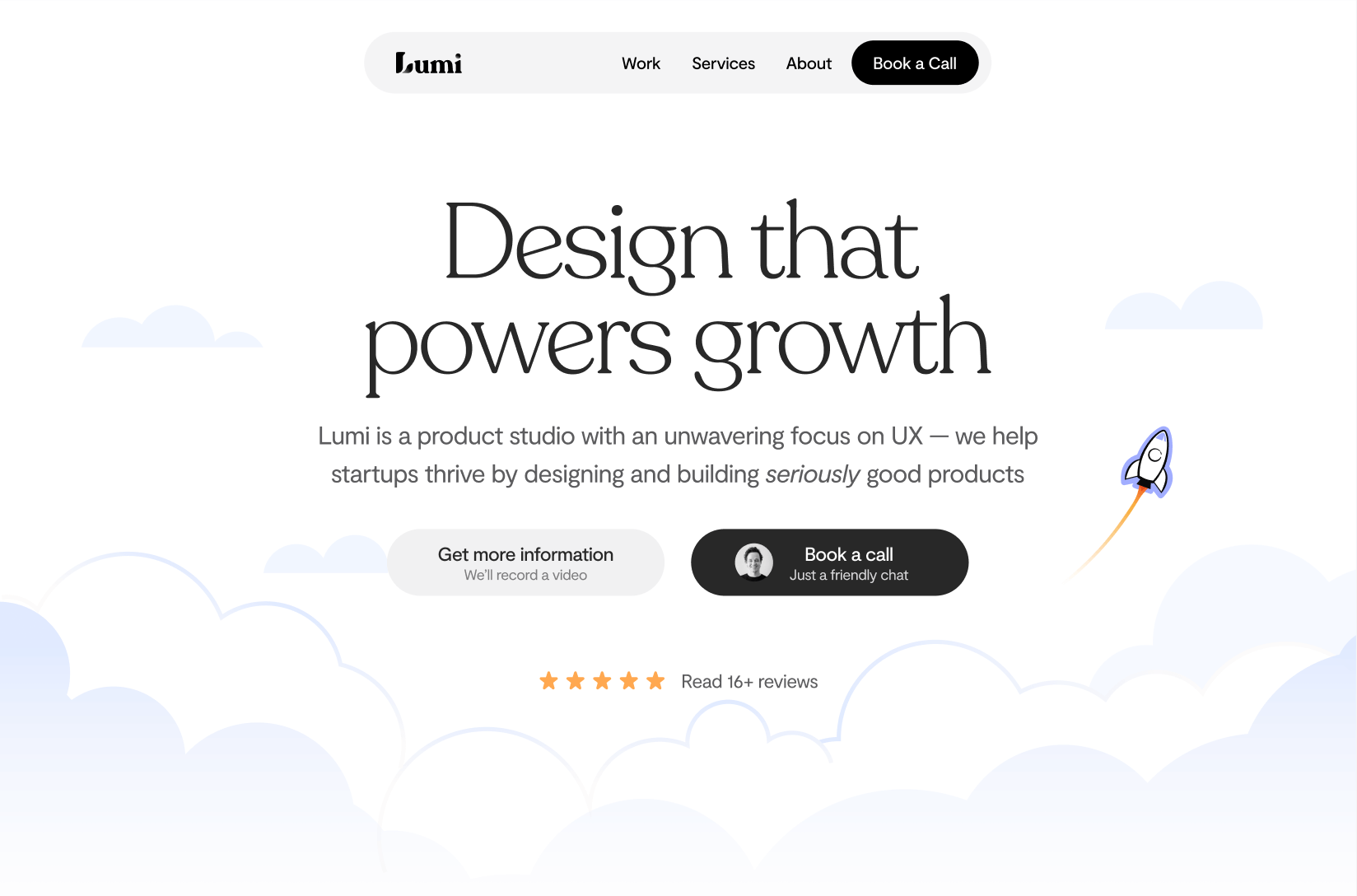
Quick stats
- Founded: 2020
- Team size: Dedicated senior product leads with startup experience
- Best for: Ambitious startups needing strategic product design and development partner
- Budget range: Flexible day rates
- Track record: Multiple client acquisitions, including strategic exits we helped architect
Lumi Studio emerged from the entrepreneurial trenches in 2020, founded by product veterans who got tired of watching brilliant founders struggle with agencies that treated startups like smaller versions of enterprise clients.
We'd spent years at companies like Trello (before Atlassian's acquisition), Robokiller (before IAC's buyout), and in the portfolios of top-tier VCs, watching the same pattern repeat: agencies would deliver flashy mockups that missed the mark on what drives startup growth.
40+ million people have used products we've helped shape. Through it all we learnt what truly drives startup success – the art of building products that not only look brilliant but convert exceptionally, scale seamlessly, and adapt quickly to market feedback.
Learn more about Lumi Product Studio's product design services →
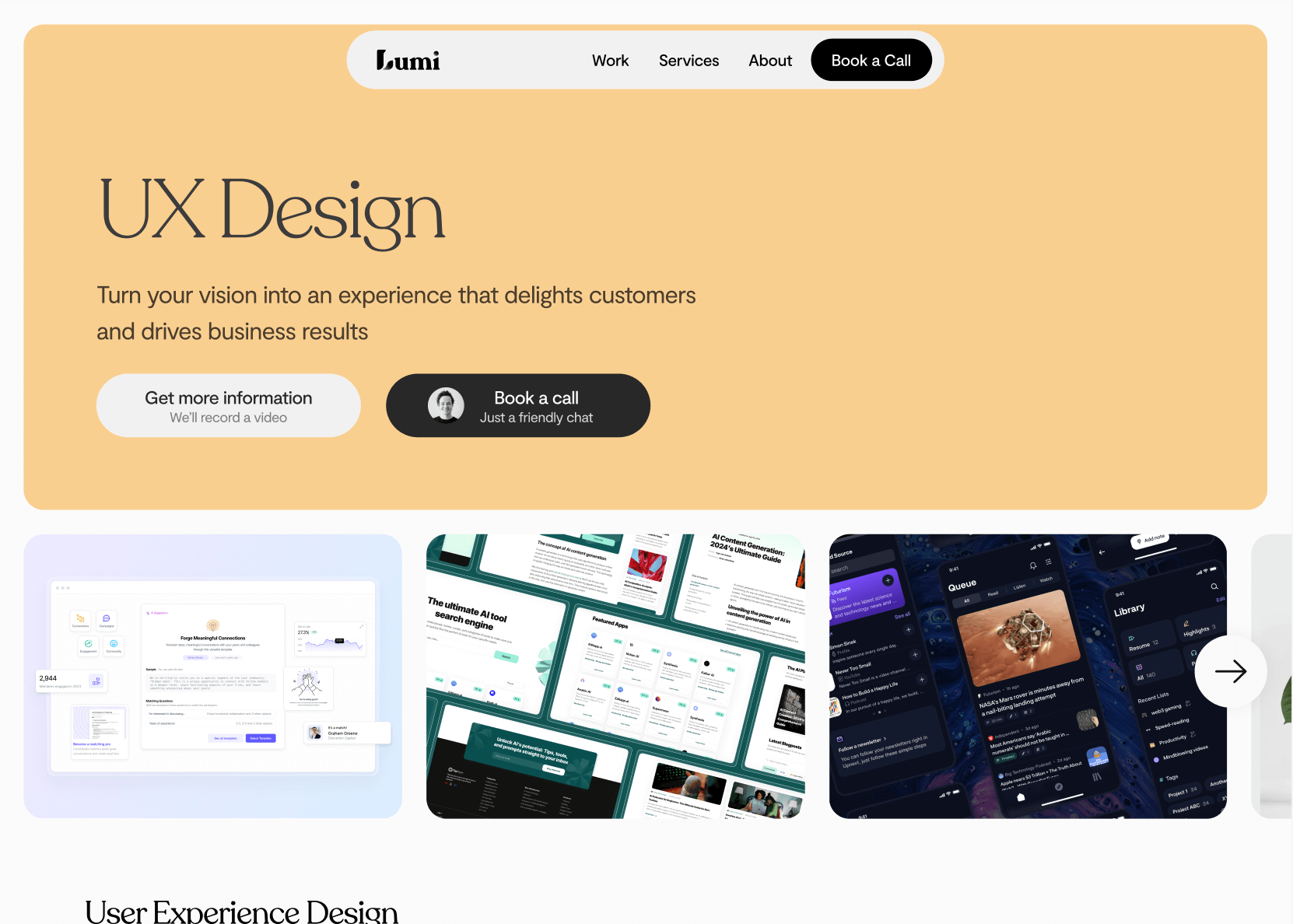
Services
🚀 Strategic Product Design & Development
- Growth-focused design and full technical build
- Modern tech stack (React, Next.js, TypeScript)
- Scalable architecture from day one
🎯 Product-Market Fit Acceleration
- Validation framework tested with 50+ startups
- Customer interviews and rapid prototype testing
- Conversion optimisation and retention strategies
🔬 Data-Driven UX Research
- User interviews, surveys, usability testing
- Customer journey optimization across your entire product suite
- In-depth user behavior analysis and friction point identification
- Conversion rate optimisation through systematic testing
⚡ Design Systems Built for Growth
- Unified design systems that eliminate visual inconsistencies
- Component libraries that scale with your growing team
- Design debt elimination and workflow standardisation
🛠️ Technical Architecture & Development
- Modern tech stack selection and headless CMS integration
- Payment processing (Stripe, PayPal) and authentication systems
- Performance audits and technical debt resolution
- Advanced analytics implementation for better decision-making
- Integration optimisation across your existing tech stack
💰 Pitch Deck & Fundraising Materials
- Investor presentations by founders with fundraising experience
- Financial visualisation and storytelling
🎨 Brand Identity
- Strategic brand positioning and complete visual identity systems
- Brand voice frameworks and marketing website design
- Marketing materials optimised for lead conversion
📈 Ongoing Growth Partnership
- Monthly growth metric analysis and optimisation planning
- Feature prioritisation and optimisation
- Team scaling guidance, mentoring and process improvement
- Competitive positioning and market differentiation strategy
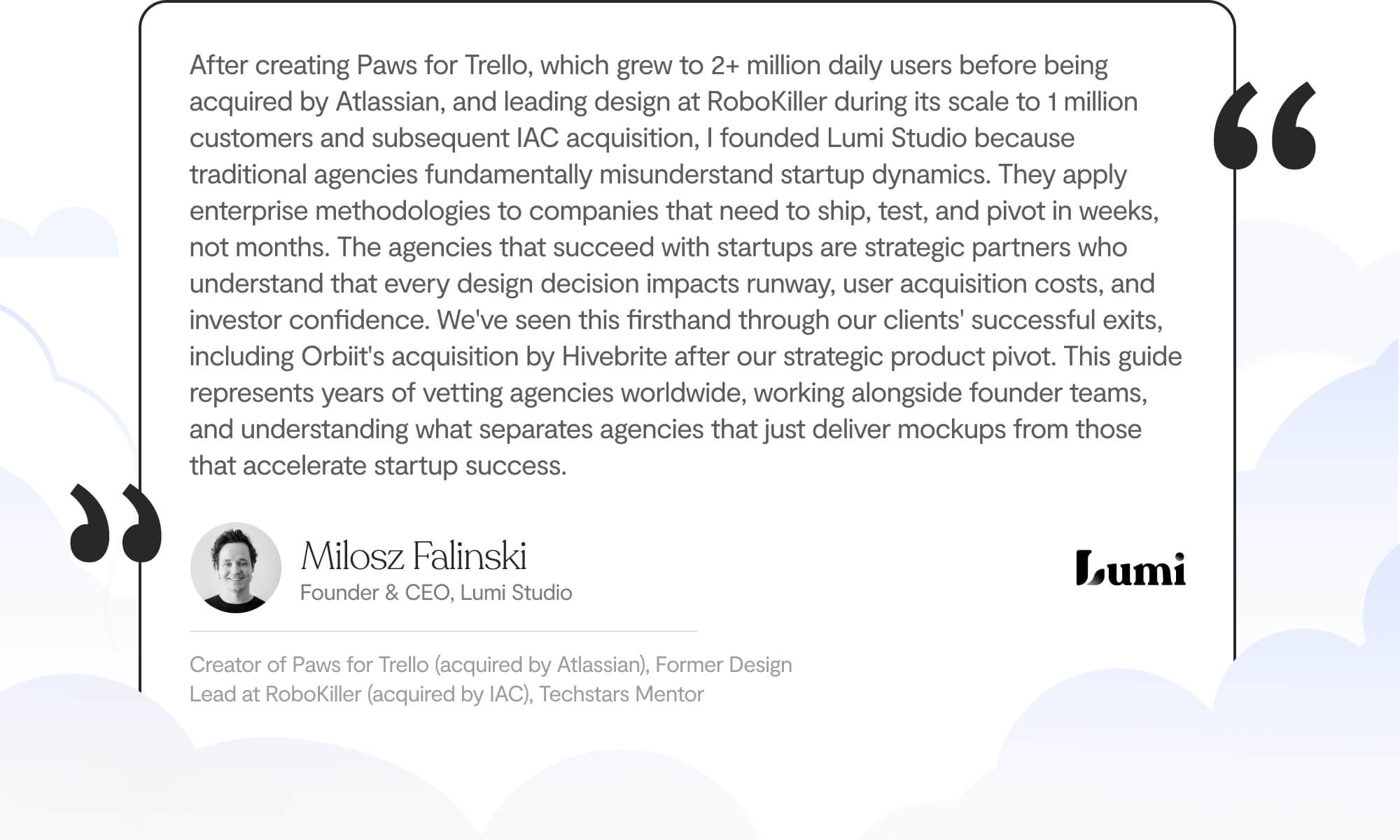
Notable success stories
Orbiit (Acquired by Hivebrite): When this established B2B platform struggled with low customer lifetime value and retention issues, Lumi led a comprehensive UX transformation. Our strategic redesign eliminated friction points for B2B decision-makers, driving a 400% increase in Average Customer Value and significantly higher retention across their user base. The optimised product experience positioned Orbiit as an attractive acquisition target, leading to their exit to Hivebrite within 12 months of our engagement.
Musiversal (€6M Series A): Portugal-based music collaboration platform connecting musicians globally for remote recording sessions. Lumi designed their complete product experience and go-to-market strategy from inception. Our strategic design work established the user experience foundation that enabled rapid user adoption and revenue growth, directly supporting their successful €6M Series A funding round and planned US market expansion.
Ovom (Berlin's Hottest Startups 2024): Featured in Wired's "The Hottest Startups in Berlin in 2024" list. Lumi designed Ovom's patient-centred user experience, supporting individuals throughout their IVF journey instead of leaving them isolated. We also worked on precision medical data visualisation for clinicians – featuring pioneering hormonal panel graphs that may represent the first of their kind in medical software – enabling unprecedented accuracy in hormonal dosing. Through these optimisations, Ovom was able to enhance their product-market fit, positioning them among Berlin's most notable startups according to Wired.
Typical process
- UX audit & growth analysis – Identify conversion blockers and design debt across your existing product
- User behavior deep-dive – Analyse actual usage patterns and friction points causing churn
- Strategic redesign sprints – Systematic optimisation of core user journeys with daily iteration
- Design system consolidation – Create cohesive visual language across your product suite
- Performance measurement & scaling – Continuous optimisation based on conversion metrics and user feedback
Timeline
As little as 2 weeks for complete product vision and functional prototype, with ongoing support for expansion and user testing.
Why startups choose Lumi
➡️ Our founder mindset. We've been founders, we've scaled products, we've made the mistakes, and we've learned what works.
➡️ Proven growth acceleration. Multiple clients have achieved significant business milestones, including Orbiit's strategic transformation that positioned them for rapid scale before their acquisition by Hivebrite. We help startups build sustainable growth engines and achieve market leadership, creating optionality for whatever path founders choose.
➡️ Speed that matches startup reality. We deliver complete product vision and functional prototypes in weeks, with investor-ready demo materials built into every project. Our design systems are architected for change, so that you can adapt quickly without rebuilding from scratch when market feedback demands iteration.
➡️ Data obsessed. We're relentlessly metric-focused because vanity metrics don't pay the bills. Every design decision is tied to measurable business outcomes – conversion rates, retention curves, customer acquisition costs, and lifetime value improvements.
➡️ True partnership. We become an extension of your team. We give you honest feedback when your ideas won't work, proactive suggestions you haven't considered, and spontaneous Slack messages when inspiration strikes.
Duck.design
🏷️ Best for Consistent Design Output
📍 London
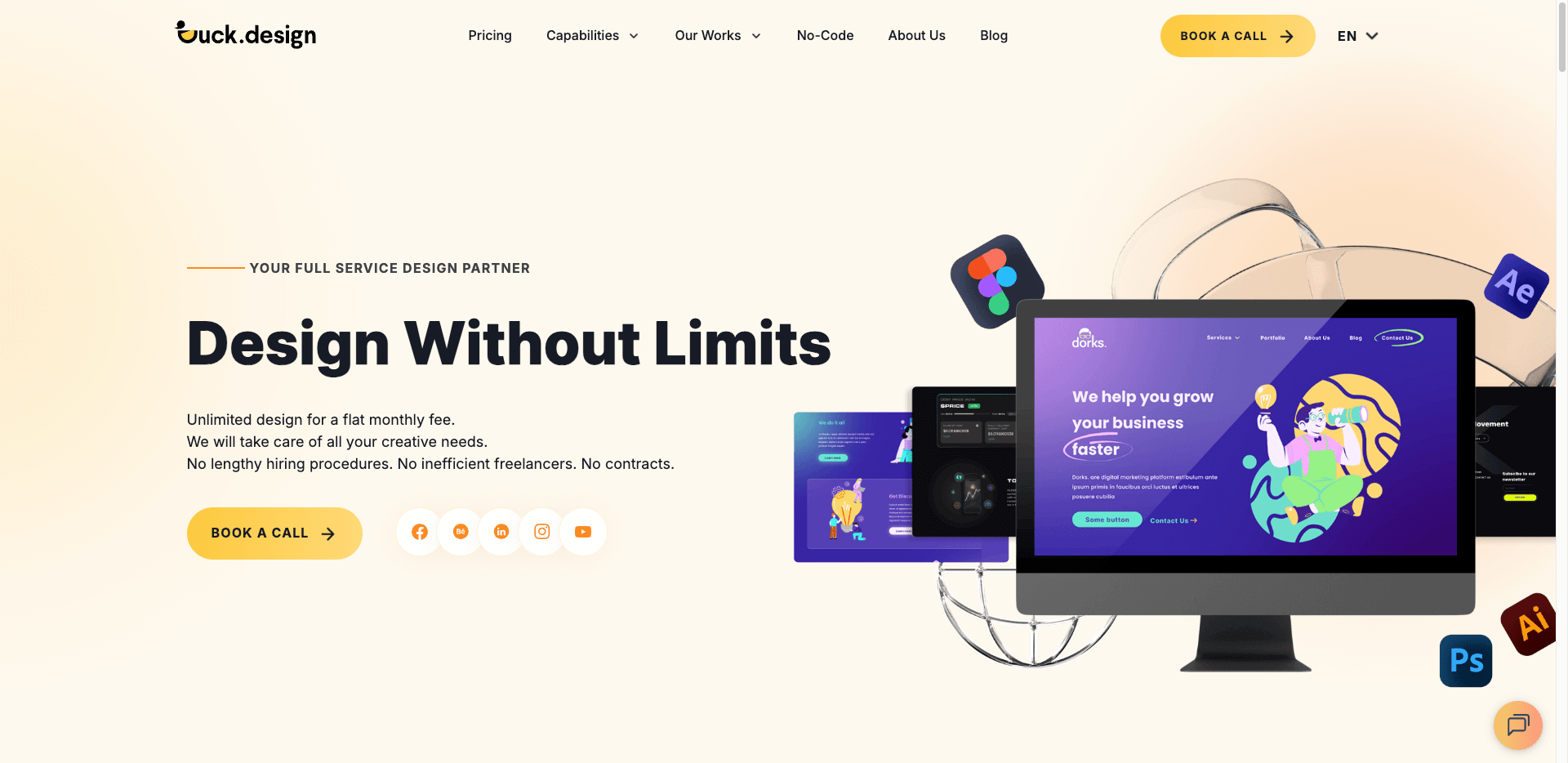
Quick stats
- Founded: 2019
- Team size: 100+ designers
- Budget range: $1,699 – $5,995/month
They've cracked the code on something most agencies struggle with – predictable costs without sacrificing quality. Their subscription model means you're never hit with surprise invoices when you need "just one more iteration." Knowing exactly what design will cost each month is genuinely liberating for founders juggling a dozen priorities
Services
- UI/UX design for web and mobile
- Brand identity and logo design
- Marketing materials and pitch decks
- No-code development (Webflow, Framer)
Notable success stories
Their startup clients report 30% increases in user engagement and 25% decreases in bounce rates after implementing Duck.design's UI improvements.
Their process
Upload request → Designer assigned → Daily updates → Unlimited revisions → Files delivered
Pros & cons
Why startups love them:
✅ Predictable monthly costs with no surprise bills or scope creep
✅ Fast turnaround times keep momentum going
✅ Same designers learn your brand over time
✅ No contracts – cancel anytime flexibility
Potential drawbacks:
❌ Limited strategic UX research capabilities
❌ Better for execution than complex UX strategy
❌ Fully remote (no face-to-face collaboration)
Cieden
🏷️ Best for B2B SaaS Complexity
📍 Ukraine with global offices

Quick stats
- Founded: 2016
- Team size: 42 distributed designers
- Budget range: $50 – $80/hour
These folks have spent years in the trenches of B2B complexity - the kind of software that makes users groan when they first log in. They've mastered the art of making powerful, feature-heavy platforms feel intuitive. If your product makes seasoned professionals more efficient, Cieden understands how to design for expertise without overwhelming newcomers.
Services
- UX research and user testing
- Complex dashboard design
- Design systems for scale
- Data visualisation interfaces
Notable success stories
Multiple clients saw 25% bounce rate reductions
Their process
Discovery → Research → Strategy → Design → Testing → Development Support
Pros & cons
Why startups love them:
✅ Deep B2B expertise with understanding of enterprise user needs
✅ Data-driven approach with decisions backed by research
✅ Competitive Eastern European pricing with Western quality standards
Potential drawbacks:
❌ Time zone differences for US clients (though well-managed)
❌ May be over-engineered for simple consumer apps
❌ Focus on complex products (not ideal for basic MVPs)
Eleken
🏷️ Best for SaaS Specialisation
📍 Ukraine with global offices

Quick stats
- Founded: 2016
- Team size: 40+ SaaS-focused designers
- Budget range: $5,000 – $200,000 projects
Eleken only works with SaaS companies, making them the most specialised UX design agency for startups in the software space. Their laser focus on SaaS is genuine obsession. They think in subscription metrics, understand why users churn in month two, and design onboarding flows that actually stick. When they say they only do SaaS, they mean they've seen every possible dashboard challenge and solved most of them.
Services
- SaaS UI/UX design and optimisation
- Dashboard and data visualisation
- User onboarding flows
- Design systems for software
Their process
Audit → Discovery → Information Architecture → UI/UX Design → Prototyping → Development Support
Pros & cons
Why startups love them:
✅ Industry obsession. They only do SaaS, so they do it extremely well
✅ Business-focused design decisions tied to SaaS metrics like activation and retention
✅ Risk-free trial period to test compatibility before committing
Potential drawbacks:
❌ SaaS-only focus (not suitable for other industries)
❌ Higher minimum investment than generalist agencies
❌ Limited availability for non-software projects
NinjaPromo
🏷️ Best for Marketing + Design Integration
📍 Lithuania with global offices
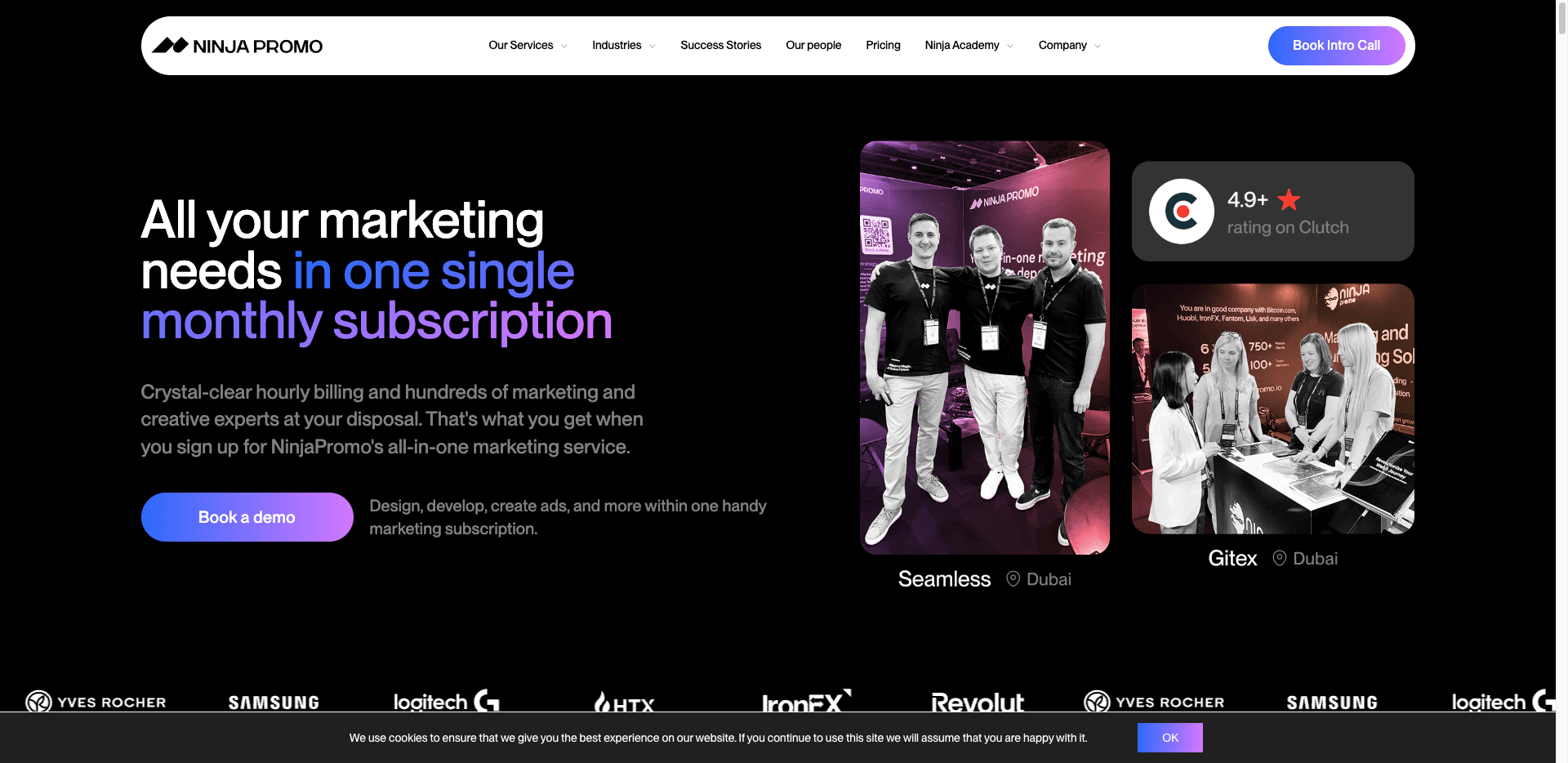
Quick stats
- Founded: 2015+
- Team size: Global distributed team
- Budget range: $3,200 – $9,600/month
Most agencies hand you beautiful designs and disappear. NinjaPromo sticks around to see if those designs actually convert. They bridge the gap between "looks amazing" and "drives revenue," treating every design decision as a growth experiment rather than an aesthetic choice.
Services
- UI/UX design and optimisation
- Performance marketing campaigns
- Landing page and funnel design
- Brand identity and messaging
Notable results
- 67% of clients see results within 30 days
- 210% sales increases for partners
- 300% engagement improvements
Their process
Strategy → Design → Marketing Integration → Testing → Optimisation
Pros & cons
Why startups love them:
✅ One-stop solution combining design and marketing under one roof
✅ Growth-focused approach where every design decision supports business KPIs
✅ Fast results with quick iteration and testing cycles
✅ Scalable team with access to specialists across multiple disciplines
Potential drawbacks:
❌ Higher minimum investment than design-only agencies
❌ May lack deep UX research capabilities
❌ Marketing focus might overshadow pure design craft
Ramotion
🏷️ Best for Silicon Valley Credibility
📍 San Francisco
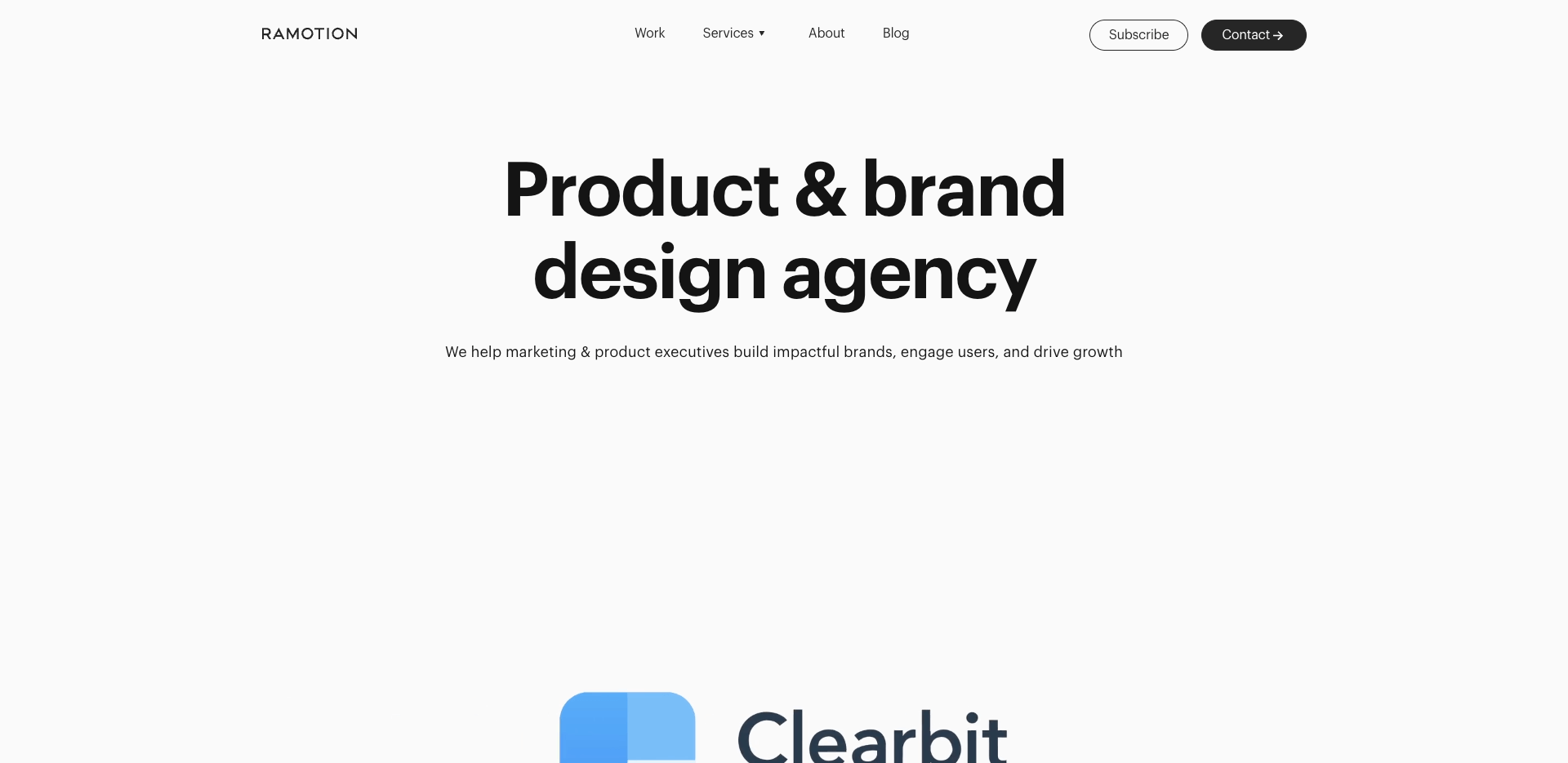
Quick stats
- Founded: 2009
- Team size: 70+ multidisciplinary experts
- Budget range: $50,000+ projects
Ramotion brings Silicon Valley design standards to startups worldwide. As one of the most established best product design studios 2025, they've helped clients raise over $1 billion and achieve multiple successful exits. They create the kind of polished, Silicon Valley-grade work that makes investors lean forward and competitors worry. They understand that sometimes you need to look bigger than you are.
Services
- Brand identity and visual systems
- Mobile and web application design
- Design systems and component libraries
- Marketing website development
Their process
Strategic → Discovery → Positioning → Concepts → Execution
Pros & cons
Why startups love them:
✅ Investor credibility – portfolio quality that impresses VCs and partners
✅ Proven ROI with track record of design driving funding and successful exits
✅ Full-stack design approach combining brand, product, and marketing alignment
Potential drawbacks:
❌ High minimum investment ($50K+) limits early-stage accessibility
❌ May be overkill for simple MVPs or rapid iteration needs
❌ Premium pricing may not suit bootstrapped startups
❌ Focus on polished products over scrappy experimentation
Clay Global
🏷️ Best for Enterprise-Grade Design
📍 San Francisco
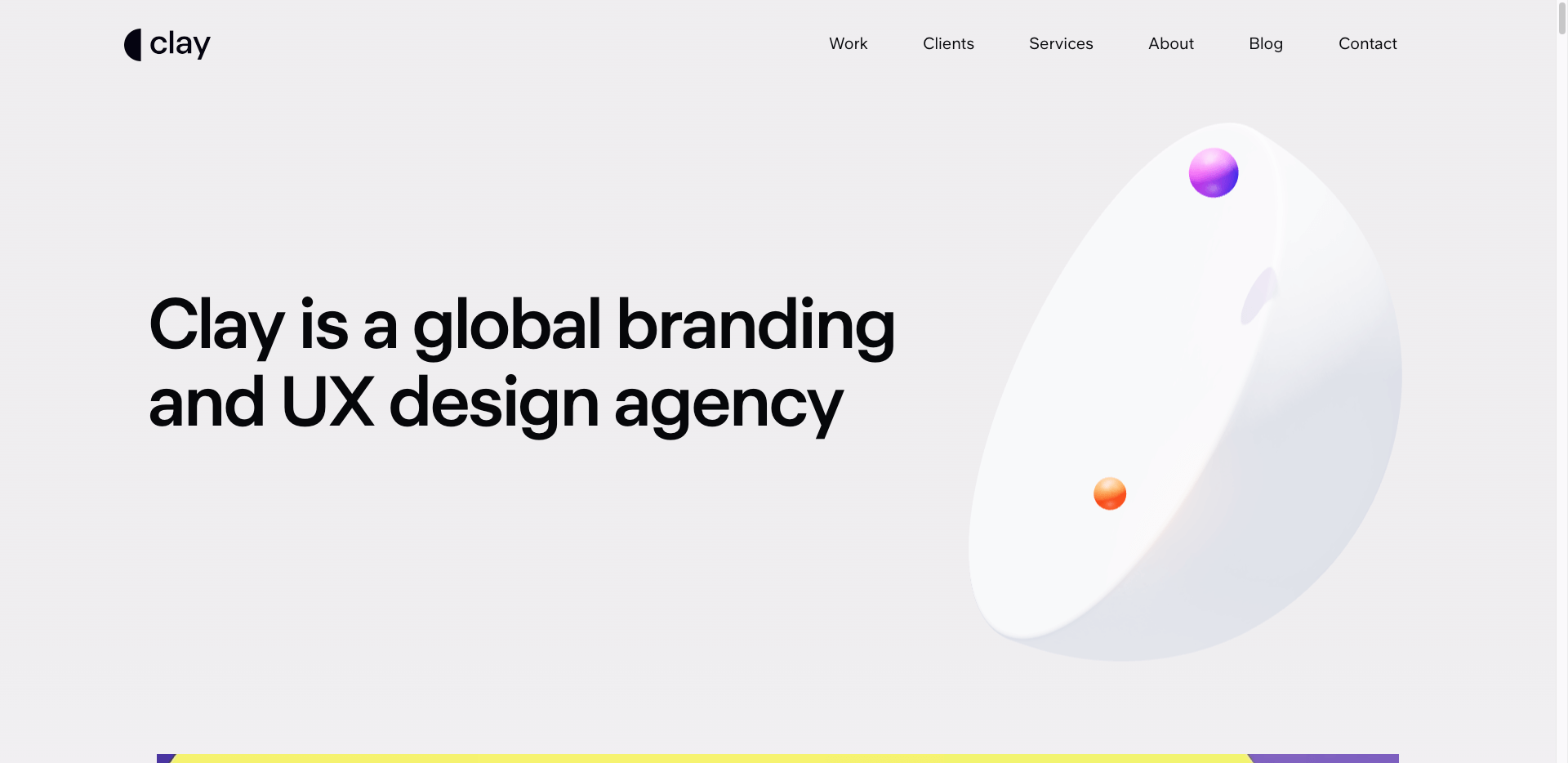
Quick stats
- Founded: 2010
- Team size: 50+ design experts
- Budget range: $75,000 – $500,000 projects
Clay Global creates premium brand and product experiences that help startups compete against enterprise incumbents. They think like enterprise buyers while designing for startup agility. Clay excels at creating products that sophisticated B2B purchasers will trust with their business-critical processes, whilst maintaining the innovation edge that differentiates you from legacy solutions.
Services
- Enterprise-grade product design
- Brand strategy and visual identity
- Design systems for complex products
- Strategic UX consulting
Notable success stories
Several portfolio companies achieved Series B+ funding rounds
Their process
Strategy & Research → Brand Positioning → Product Design → Enterprise Readiness
Pros & cons
Why startups love them:
✅ Deep understanding of B2B buyer psychology and decision-making
✅ Premium portfolio quality that stands up to incumbent competition
Potential drawbacks:
❌ High investment threshold limits early-stage access
❌ Enterprise focus may feel slow for rapid iteration needs
❌ Overkill for simple consumer products or MVPs
❌ Long timeline may not suit urgent launch deadlines
Awesome NYC
🏷️ Best for NYC Startup Ecosystem Integration
📍 New York City
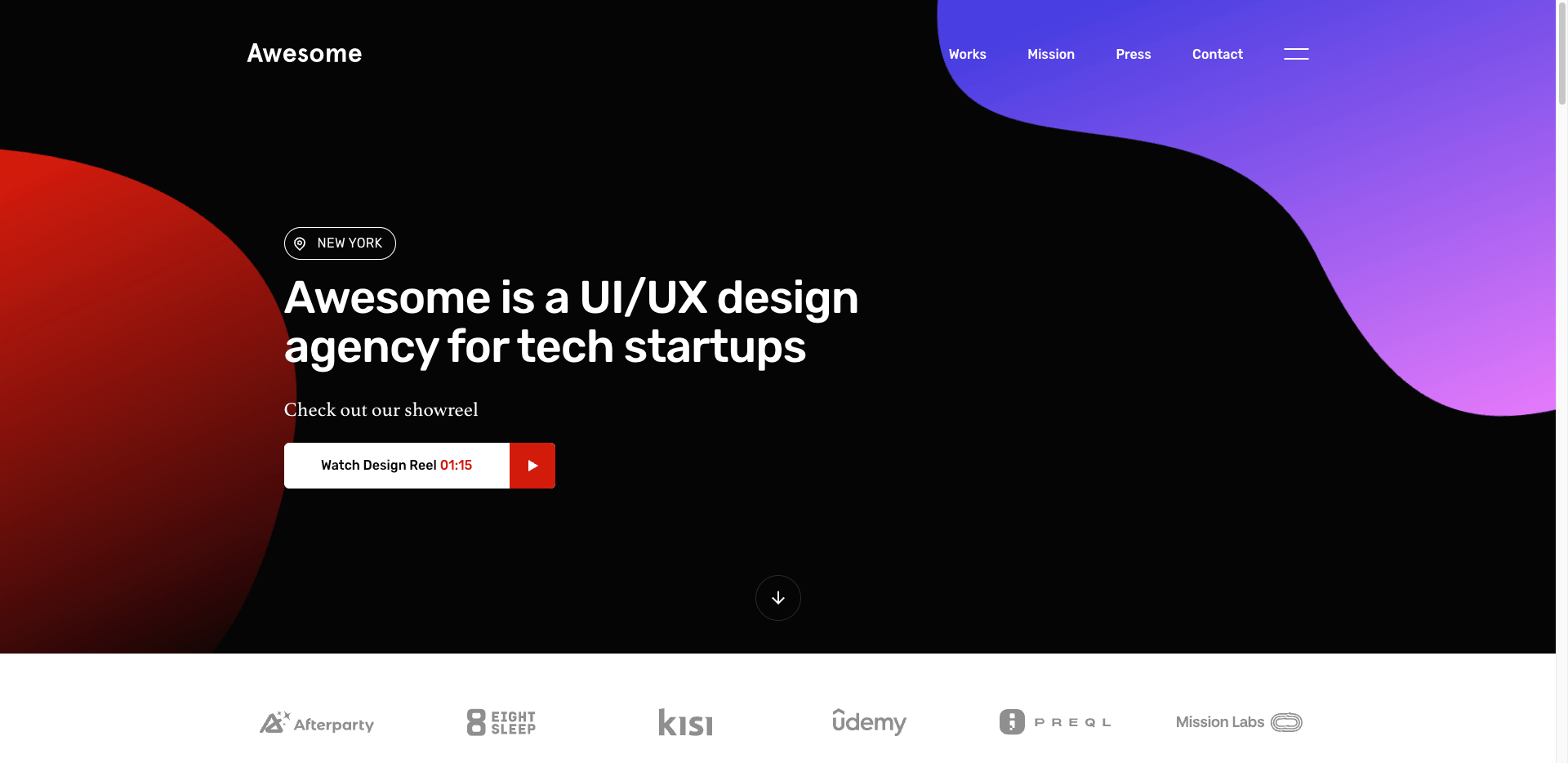
Quick stats
- Founded: 2018
- Team size: 25+ NYC-based designers
- Budget range: $50,000 – $200,000 projects
They're plugged into the unique rhythm of East Coast fundraising - the different investor expectations, the faster decision cycles, the emphasis on business fundamentals over flashy demos. Being physically present in Manhattan for crucial meetings matters more than remote-first agencies admit, and they understand the subtle cultural differences that can make or break NYC startup success.
Services
- Product design and user experience
- Brand identity and positioning
- Investor deck and pitch design
- Strategic design consulting
Their process
NYC Market Analysis → Strategic Design → Ecosystem Integration → Launch Support
Pros & cons
Why startups love them:
✅ Native understanding of NYC startup culture and investor expectations
✅ Network connections that extend beyond design work
✅ Experience with East Coast funding cycles and demo day requirements
✅ Local face-to-face collaboration in Manhattan
Potential drawbacks:
❌ Geographic focus may not suit West Coast or international startups
❌ Premium NYC pricing reflects local market rates
❌ Smaller team size limits capacity for simultaneous projects
❌ Less suitable for non-tech industries
Musemind
🏷️ Best for AI-Enhanced Design Innovation
📍 Global
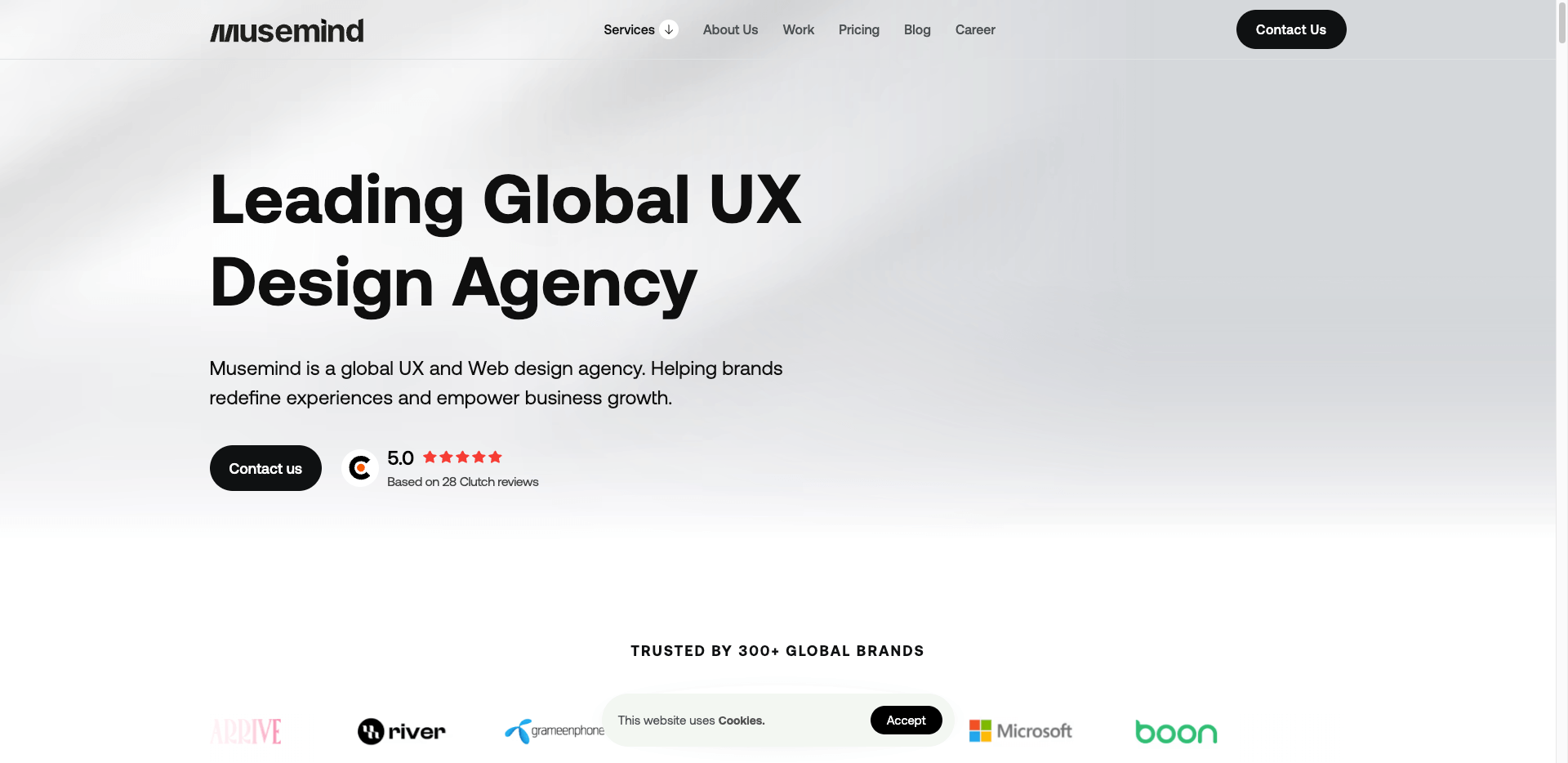
Quick stats
- Founded: 2021
- Team size: 40+ AI-forward designers
- Budget range: Custom pricing based on AI complexity
They're designing for the future that's already here. Whilst other agencies are still figuring out how to integrate AI features, Musemind builds products that assume AI capabilities from day one. They understand that conversational interfaces and predictive experiences aren't gimmicks - they're the new baseline for competitive advantage.
Services
- AI-enhanced design workflows
- Conversational UI/UX design
- Data visualisation and dashboard design
- Machine learning UX optimisation
Their process
AI Analysis → Human-Centered Design → ML Integration → Continuous Optimisation
Pros & cons
Why startups love them:
✅ Cutting-edge approach that matches modern startup tech stacks
✅ Understanding of AI/ML constraints and opportunities in design
✅ Faster iteration cycles through AI-assisted design processes
✅ Future-ready design systems that adapt to changing data
Potential drawbacks:
❌ May be overkill for traditional software without AI components
❌ Newer agency with shorter track record than established competitors
❌ AI-enhanced approach may feel impersonal to some founders
❌ Custom pricing model requires detailed scoping discussions
Zajno
🏷️ Best for Standout Creative Experiences
📍 Delaware
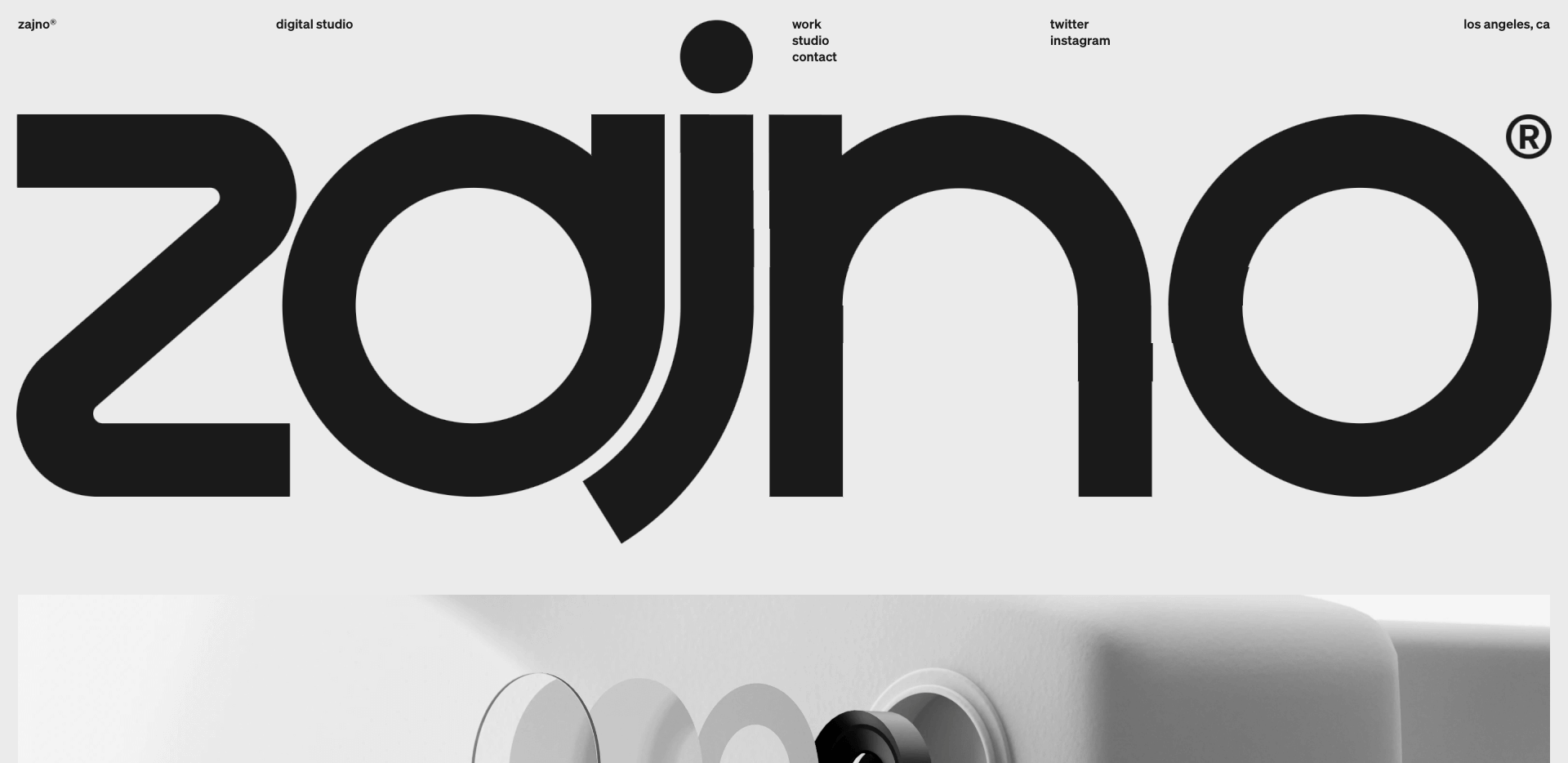
Quick stats
- Founded: 2016
- Team size: 35+ creative specialists
- Budget range: $25,000 – $150,000 projects
They create the kind of experiences that users screenshot and share on social media. In a world where every SaaS dashboard looks identical, Zajno crafts interfaces that become talking points. Their work generates genuine excitement and word-of-mouth marketing that money can't buy.
Services
- Interactive web experiences
- Motion design and animation
- Brand identity and visual systems
- Mobile app design with creative flair
Notable success stories
- Multiple clients featured in design award competitions
- Portfolio work regularly shared on design inspiration sites
Their process
Creative Strategy → Visual Exploration → Interactive Prototyping → Premium Execution
Pros & cons
Why startups love them:
✅ Creative approach that helps brands stand out in crowded markets
✅ Strong motion design and animation capabilities
✅ Design work that performs well on social media and marketing
Potential drawbacks:
❌ Creative focus may sometimes overshadow usability considerations
❌ Higher cost per screen due to premium execution standards
❌ May not suit highly functional B2B software applications
❌ Longer timelines due to detailed creative processes
Fuselab Creative
🏷️ Best for Strategic UX Consulting
📍 Washington DC
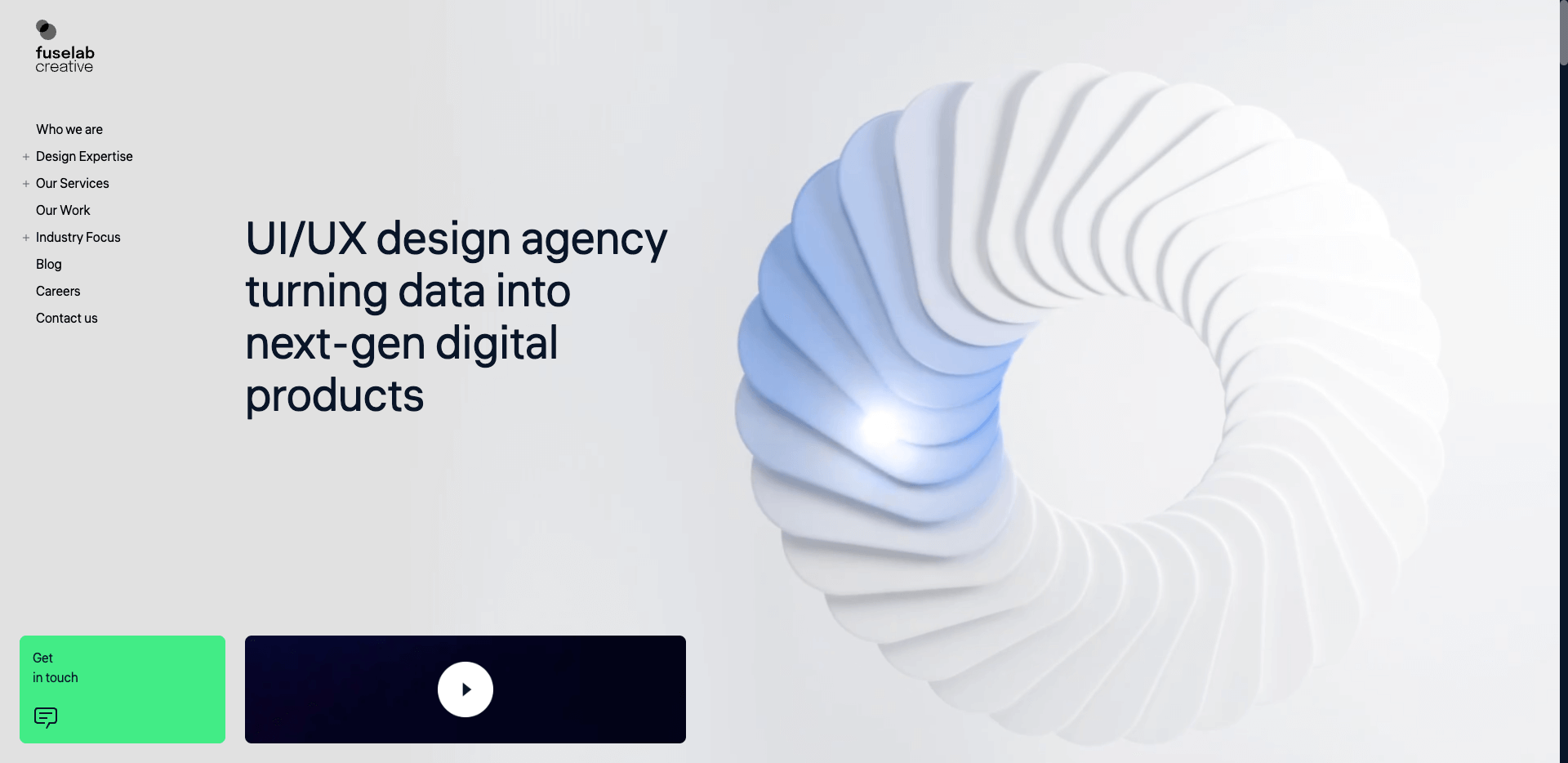
Quick stats
- Founded: 2012
- Team size: 20+ UX strategists
- Budget range: $75,000 – $300,000 engagements
They bring academic rigour to startup chaos. Fuselab invests in understanding the deeper behavioural patterns that drive user decisions. Their research-heavy approach might feel slow initially, but it prevents the costly pivots that happen when assumptions prove wrong six months later.
Services
- Comprehensive UX research and strategy
- Human-centered design methodology
- Accessibility and compliance consulting
- Design thinking workshops and facilitation
Their process
Research & Discovery → Strategy Development → Design Validation → Implementation Guidance
Pros & cons
Why startups love them:
✅ Expertise in regulated industries and complex compliance requirements
✅ Strong track record with government and healthcare clients
Potential drawbacks:
❌ Research-heavy approach may feel slow for rapid iteration needs
❌ Higher investment threshold due to strategic consulting model
❌ May be overkill for simple consumer applications
❌ Longer engagement timelines than execution-focused agencies
Aufait UX
🏷️ Best for Budget-Conscious Early-Stage Startups
📍 India
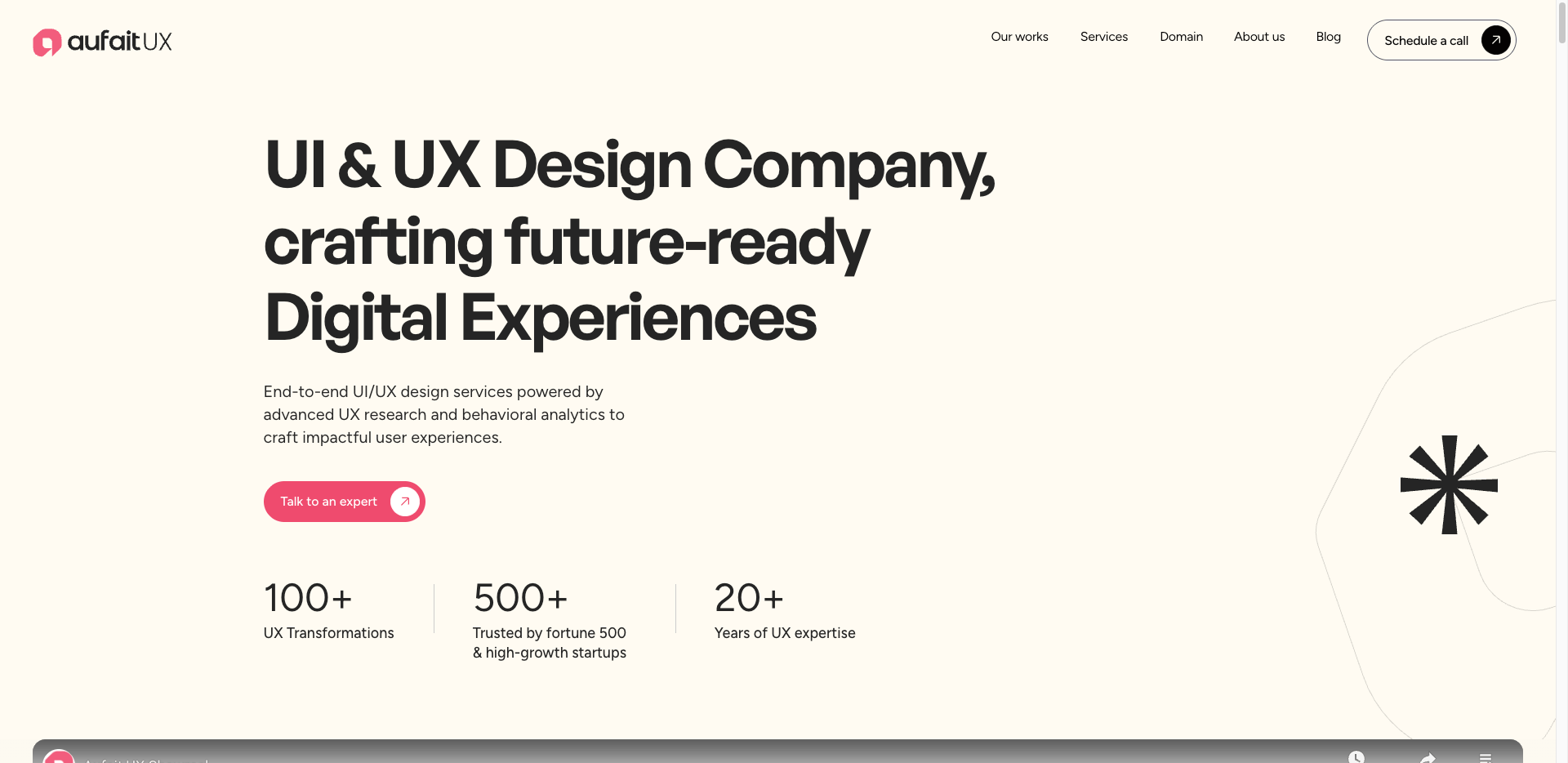
Quick stats
- Founded: 2017
- Team size: 15+ efficient designers
- Budget range: $15,000 – $75,000 projects
They prove that bootstrap budgets don't have to mean amateur results. Aufait delivers genuinely professional work at prices that won't consume your entire pre-seed round. They understand the specific constraints of early-stage founders and design processes that maximise impact whilst respecting financial realities.
Services
- MVP design and rapid prototyping
- User research and validation
- Mobile and web application design
- Conversion optimisation consulting
Their process
Budget Planning → Rapid Design → Feedback Integration → Launch Optimisation
Pros & cons
Why startups love them:
✅ Accessible pricing that fits early-stage budgets
✅ Understanding of bootstrap startup challenges and priorities
✅ Flexible engagement models and payment terms
Potential drawbacks:
❌ May lack the premium polish of higher-priced alternatives
❌ Time zone differences for real-time collaboration
❌ Smaller team size may limit capacity during busy periods
❌ Less suitable for highly complex enterprise software
Fantasy
🏷️ Best for Consumer Product Innovation
📍 San Francisco & New York

Quick stats
- Founded: 2009
- Team size: 60+ consumer-focused designers
- Budget range: $100,000 – $500,000 projects
They bridge the gap between digital and physical in ways that most agencies can't comprehend. Fantasy thinks beyond screens to consider how products live in users' daily routines, how packaging influences perception, and how retail presence affects brand credibility. They design complete experiences, not just interfaces.
Services
- Product strategy and positioning
- Industrial design integration
- Brand experience design
- Consumer research and insights
Notable success stories
- Multiple products featured in Apple stores and major retail
- Several clients achieved successful consumer product launches
- Portfolio includes award-winning consumer experiences
Their process
Consumer Insights → Product Strategy → Experience Design → Market Launch
Pros & cons
Why startups love them:
✅ Deep expertise in consumer product development and market entry
✅ Integration of physical and digital product design
✅ Strong portfolio of successful consumer product launches
✅ Understanding of retail and distribution channels
Potential drawbacks:
❌ High minimum investment limits early-stage accessibility
❌ Consumer focus may not suit B2B software companies
❌ Longer development cycles typical for physical products
❌ San Francisco pricing reflects premium market rates
IDEO
🏷️ Best for Design Thinking and Innovation
📍 Global

Quick stats
- Founded: 1991
- Team size: 700+ design thinkers globally
- Budget range: $300,000 – $1,000,000+ engagements
They invented the playbook that everyone else follows. IDEO's design thinking methodology has become standard practice across Silicon Valley, but working directly with the originators means accessing insights and approaches that haven't been commoditised yet. They tackle problems that require inventing entirely new categories, not just improving existing ones.
Services
- Design thinking workshops and methodology
- Innovation strategy and market creation
- Human-centered design research
- Organisational design transformation
Their process
Inspiration → Ideation → Implementation → Integration
Pros & cons
Why startups love them:
✅ Pioneering design thinking methodology and innovation expertise
✅ Track record of creating entirely new product categories
✅ Access to world-class innovation thinking and methodologies
✅ Portfolio includes many breakthrough innovations and market creators
Potential drawbacks:
❌ Extremely high investment threshold limits accessibility
❌ Enterprise focus and methodology may not suit typical startup speed
❌ Innovation consulting approach may be overkill for execution needs
❌ Long engagement timelines not suitable for rapid product development
Frog Design
🏷️ Best for Human-Centered Enterprise Transformation
📍 San Francisco, Austin, New York, Seattle, Milan
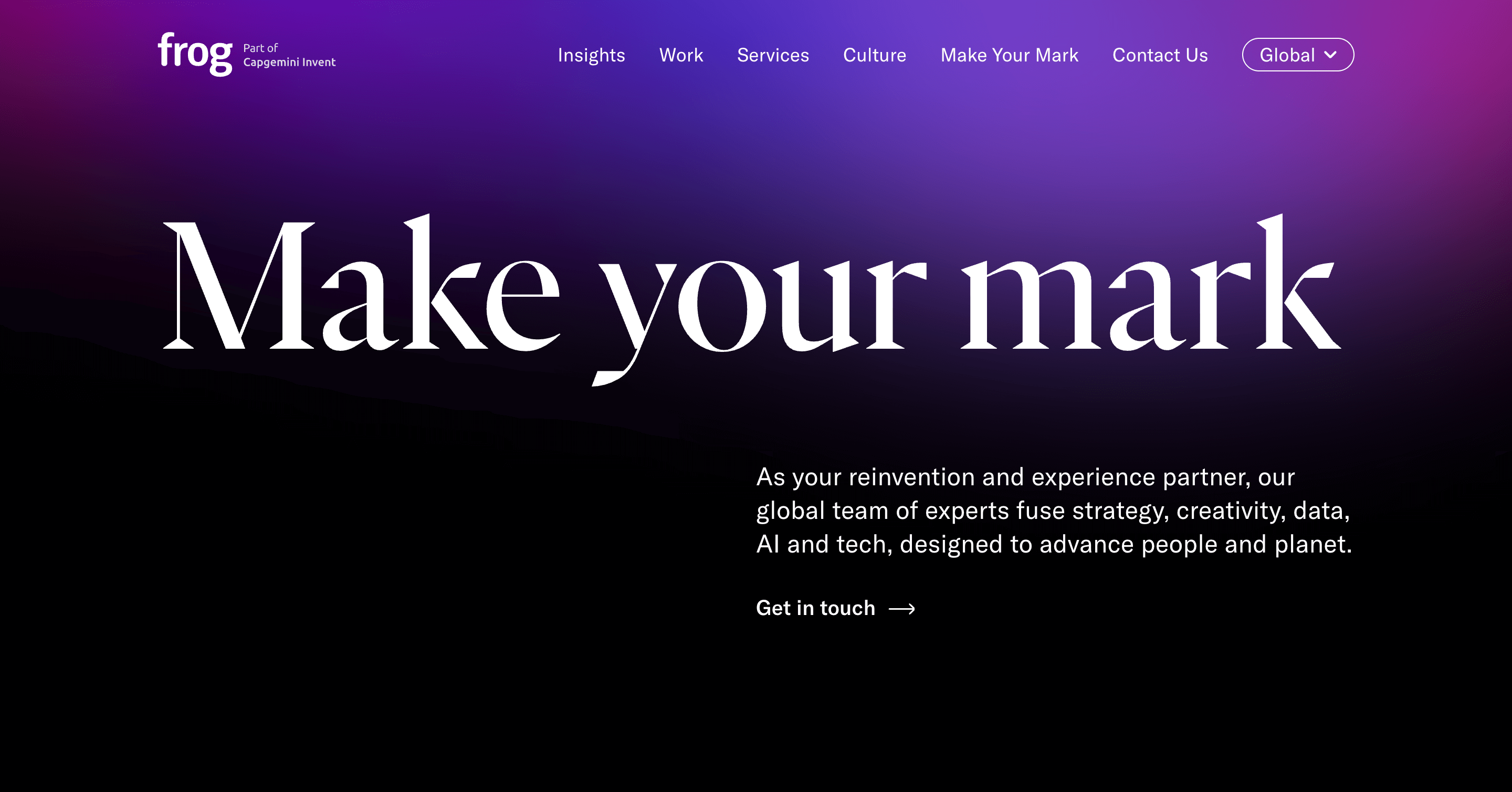
Quick stats
- Founded: 1969 (50+ years of experience)
- Team size: Part of Capgemini Invent (global scale)
- Budget range: Contact for custom pricing (typically $200K+ projects)
They bring five decades of design evolution to modern challenges. Frog has witnessed and shaped every major shift in human-computer interaction, from the earliest Apple interfaces to today's AI-powered experiences. Their institutional memory prevents reinventing solutions that have already been tested and refined over generations of products.
Services
- Human-centered design methodology
- Business transformation consulting
- Product strategy and realisation
- Experience strategy and service design
Notable success stories
- Strategic partnerships with Sky, Visa, UBS, Nike, UNICEF
- Academy Award for technical achievement (1986)
Their process
Strategy & Research → Human-Centered Design → Business Transformation → Future Visioning
Pros & cons
Why startups love them:
✅ Design heritage with decades of human-centered innovation
✅ Proven track record with global brands
Potential drawbacks:
❌ Enterprise focus makes them less suitable for early-stage startups
❌ Premium pricing reflects their prestigious positioning and enterprise scope
❌ Complex organisational structure may slow decision-making for agile projects
❌ May be overkill for companies needing straightforward UI/UX work
Work & Co
🏷️ Best for Premium Digital Product Excellence
📍 Brooklyn, Portland, São Paulo, Rio, Copenhagen, Belgrade, LA, Atlanta
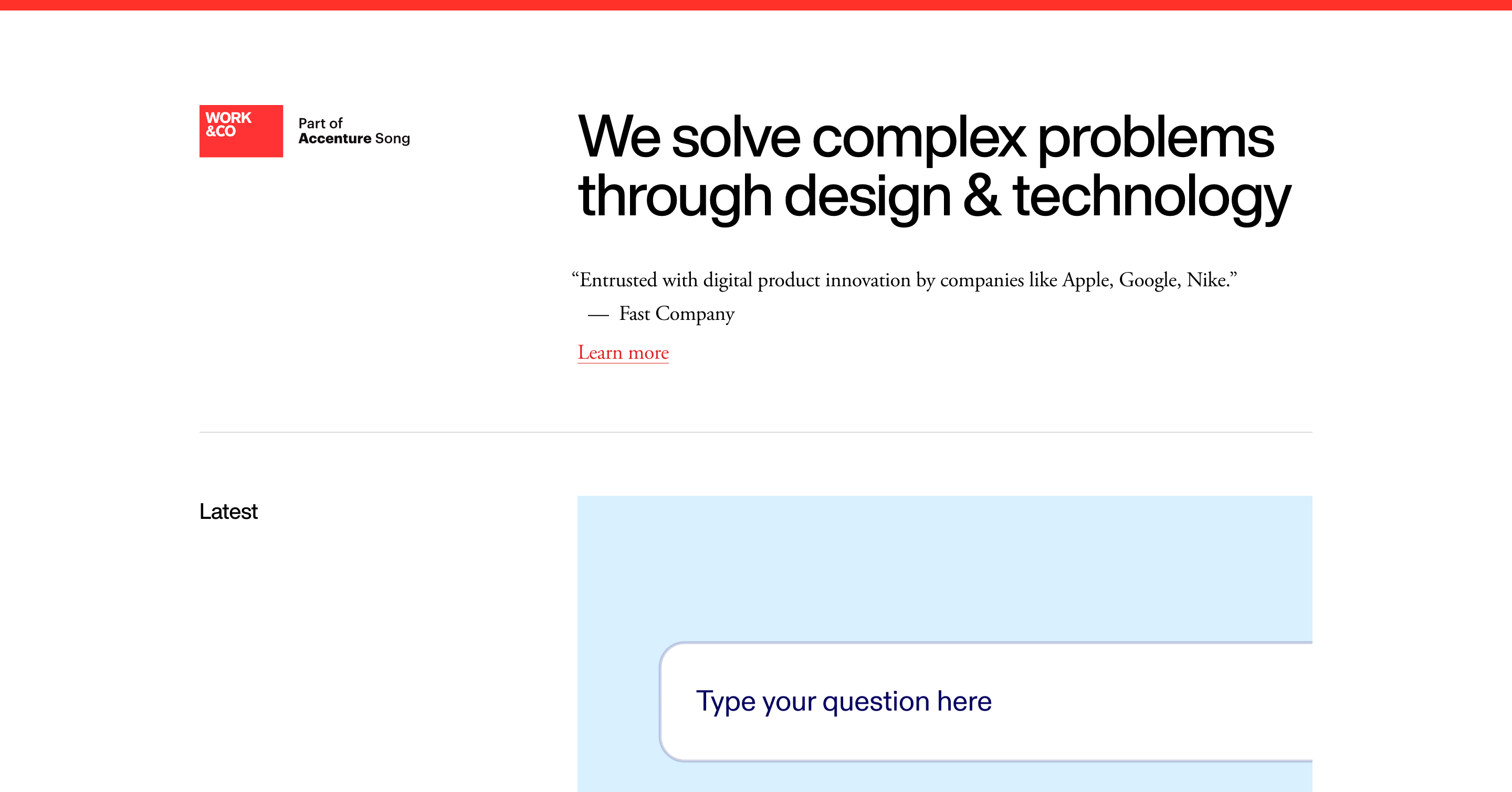
Quick stats
- Founded: 2013
- Team size: 425+ employees globally
- Budget range: Contact for custom pricing (premium enterprise rates)
They operate with the kind of senior-only teams that most agencies promise but few deliver. No junior designers learning on your project, no account managers who don't understand the work. Their "no timesheets" policy means focus stays on outcomes rather than billable hours.
Services
- End-to-end digital product development
- E-commerce platforms and mobile apps
- AI tools and physical-digital experiences
- Strategic product consulting
Notable success stories
- Apple: Global partnership for Today at Apple retail program
- Virgin America: First fully responsive airline website (Bronze Lion winner)
- PepsiCo: Multi-year partnership including Gatorade digital ecosystem
Their process
Collaborative Discovery → Rapid Prototyping → Iterative Development → Continuous Testing
Pros & cons
Why startups love them:
✅ Elite client roster proves ability to meet the highest standards
✅ Dedicated senior teams eliminate typical agency juggling and junior involvement
Potential drawbacks:
❌ Premium positioning means high investment threshold
❌ Selective about clients — not accessible to all companies
❌ Focus on large-scale products may not suit simple projects
What startup UX looks like in 2025
Having guided 50+ startups through the gauntlet from idea to exit, we've seen which design decisions make or break companies.
Plot twist: it rarely comes down to aesthetics.
The UI UX design agency for startups world has matured from "pixel-perfect mockups" to "business-critical growth engines." Here's the inside track on what drives results in 2025 ⬇️

🤖 AI-native experiences
75% of companies plan to integrate conversational AI into their interfaces within two years, and by 2030, 90% of user interfaces will use AI to customise experiences.
But successful startups aren't bolting AI onto existing flows, they're rebuilding experiences around AI-first interactions.
What we're seeing work ⬇️
- Conversational interfaces replacing complex forms: Instead of 47-field signup flows, startups are using AI chat to gather information naturally
- Predictive UX that anticipates needs: Your product learns user patterns and surfaces relevant features before they're requested
- Context-aware assistance: AI that understands where users are stuck and offers specific help, not generic tutorials
⚠️ Don't add AI because it's trendy. Add it because it makes your core user journey faster, clearer, or more successful. We've seen a lot of products complicate simple flows with "smart" features that confuse users more than help them.
📈 Product-led growth becomes product-led everything
91% of B2B SaaS companies have deployed PLG, with successful startups delivering value within 2-3 minutes of signup. The old model of "demo → sales call → onboarding" is dead. 9% of free accounts convert to paid, with products under $5K ACV seeing the highest conversion rates.
The new PLG playbook
- Self-serve everything: From signup to upgrade, users should never need to wait for you
- Value-first onboarding: Get users to their "aha moment" in under 5 minutes, not 5 days
- Usage-based progression: Let product engagement, not sales calls, drive upgrade decisions
- Built-in virality: Make sharing and collaboration core to the experience, not an afterthought
➡️ Your interface needs to be your sales team, your onboarding specialist, and your customer success manager. Every screen should either deliver value or move users closer to it.
🎯 Hyper-personalisation
71% of consumers expect personalised interactions, and 76% get frustrated when this doesn't happen.
But startups that nail personalisation focus on behavioral adaptation, not personal data collection.
Personalisation to focus on in 2025 ⬇️
- Role-based interfaces: Your dashboard shows different features for admins vs. end users automatically
- Progressive complexity: Advanced features appear as users demonstrate readiness for them
- Context-aware suggestions: Recommendations based on what users are trying to accomplish, not what they browsed yesterday
- Adaptive onboarding: First-time founder? You see different guidance than a repeat entrepreneur
Personalise based on how users use your product, not just for the sake of it. Focus on building trust in relevant ways.
🚀 Speed-to-value architecture
In 2025, "time-to-value" isn't measured in days, it's measured in seconds. Successful PLG startups deliver instant value with the most successful companies averaging 2-3 minutes to first "wow moment".
The new speed standards ⬇️
- Progressive disclosure: Show users exactly what they need, when they need it, nothing more
- Smart defaults: Every setting should work perfectly out-of-the-box for 80% of users
- Contextual micro-onboarding: Just-in-time education, not upfront feature tours
- One-click value: Users should accomplish something meaningful on their first interaction
👀 Every additional click between signup and success kills conversion.
🔧 Component-first design systems from day one
Enterprise companies spend months building design systems. Smart startups start with them. Companies that prioritise design achieve 32% higher revenue growth and grow twice as fast as industry benchmarks.
Why this matters for startups
- Consistent experiences across rapid feature development: New features feel native, not bolted-on
- Easier A/B testing: Change button styles globally, not screen-by-screen
- Developer handoff that actually works: Components translate directly to code
- Scale-ready foundations: Adding team members doesn't break visual consistency
We approach this by building evolutionary design systems, starting minimal but structured to grow. Your button component works the same whether you have 5 screens or 500.
🌍 Sustainable UX
With growing awareness around how much energy digital products consume, startups are optimising for performance and efficiency to reduce unnecessary data usage.
Sustainable design choices
- Performance-first architecture: Faster loading = lower energy consumption = better user experience
- Efficient imagery and media: Optimise for mobile-first, desktop-second
- Dark mode as default: Reduces device energy consumption, especially on OLED screens
- Minimal data requests: Every API call should serve multiple purposes
Sustainable UX often correlates with better UX. Lighter, faster, more efficient products create happier users and lower infrastructure costs.
🔮 UX that grows with you
The biggest shift we've observed doesn't stem from any single technology, but rather centres on adaptive product experiences. High-growth startups of 2025 build products that evolve with their users and their business.
What this looks like ⬇️
- Interfaces that scale complexity with user sophistication
- Feature discovery that matches user readiness
- Onboarding that adapts based on company size and industry
- Analytics relevant to user goals, not just usage
You don't know exactly what your users need until they show you. Build products that learn and adapt, don’t just deliver predetermined experiences.
Final thoughts
The agencies in this guide represent the top 1% of startup-focused design partners worldwide. Each has proven they understand the unique pressures of building products that need to ship fast, iterate quickly, and scale efficiently.
Your choice depends on three factors: your current stage, available budget, and specific product challenges.
The wrong agency will cost you months of momentum. The right agency will compress your timeline from idea to market leadership.
Join the founders who chose growth over guesswork → Book a no-pressure call with Lumi Studio's startup veterans
Frequently Asked Questions
What is the best UI/UX agency for startups in 2025?
There's no single "best" agency, it depends on your stage, budget, and needs:
- Complete product partnership: Lumi Studio
- Budget-conscious: Duck.design or Cieden
- B2B SaaS focus: Lumi Studio, Eleken or Cieden
- Growth-stage/Well-funded: Lumi Studio, Ramotion or Clay Global
- Creative/Consumer products: Zajno or Musemind
How much does a UI/UX design agency cost for a startup?
UI/UX design services for startups range widely:
- Subscription models: $1,700 – $10,000/month
- MVP design: $15,000 – $50,000
- Full product design: $50,000 – $150,000
- Enterprise-level: $150,000 – $500,000+
Budget 10-20% of your total development costs for design.
Should I hire a freelancer or a UI/UX agency for my startup?
Choose freelancers for:
- Simple, well-defined projects
- Very tight budgets (under $10K)
- Single-skill needs (just UI or just UX)
Choose agencies for:
- Complex products requiring multiple skills
- Ongoing design needs
- Strategic UX guidance
- Faster timelines and dedicated support
What services do UI/UX agencies provide for early-stage startups?
Most UI UX companies for early-stage startups offer:
- User research and validation
- Wireframing and prototyping
- UI design and visual systems
- Development handoff support
- Basic user testing
- Design systems for scaling
How do I know if a UI/UX agency is right for my startup?
Use this how to choose a UI/UX agency for startups checklist:
- Have they worked with startups at my stage? Look for specific examples
- Can they show measurable outcomes? Conversion improvements, faster launches, etc.
- Do they understand my business model? SaaS, marketplace, consumer app, etc.
- Are they flexible with scope and pricing? Startups change quickly
- Do they provide strategic input? Not just execution
Can I get an MVP designed in under 6 weeks?
Yes, if you work with agencies experienced in rapid startup delivery:
- Lumi Studio: Unique strategic process transforms ideas into acquisition-ready products in weeks, not months – complete product vision, functional prototypes, and growth-driven design from founders who've been where you are
- Duck.design: Can deliver screens within days
- Cieden: 4-6 week MVP timelines typical
- NinjaPromo: Fast iteration cycles for growth testing
Key: Have your requirements clear and be available for daily feedback.
Do UI/UX agencies help with investor decks and pitch materials?
Many startup-focused agencies include pitch deck design:
- Lumi Studio: End-to-end fundraising strategy from founders who've raised and exited – pitch decks, demo materials, financial projections visualisation, and investor meeting preparation
- Duck.design: Pitch decks included in subscription package
- Ramotion: Investor presentation design services
- Awesome NYC: Founded by startup veterans who understand fundraising
What's the cheapest way for a startup to test UI/UX?
Budget testing options:
- Lumi Studio: Complete product validation with functional prototypes in 2 weeks. Everything you need for confident product decisions
- Duck.design subscription: Quick concept testing via templates
- Freelancer + tools: Basic user testing on a project basis
- DIY tools: Figma + Maze/UserTesting for basic validation
- Design sprints: Single-week workshops with limited follow-through
Do agencies work for equity or deferred payment?
Rare but possible: Some agencies work for equity, especially:
- Very early-stage startups with compelling vision
- Agencies that also invest (hybrid model)
- Long-term strategic partnerships
Most established top UI/UX design agencies for startups may offer flexible payment terms for strong partnerships.





